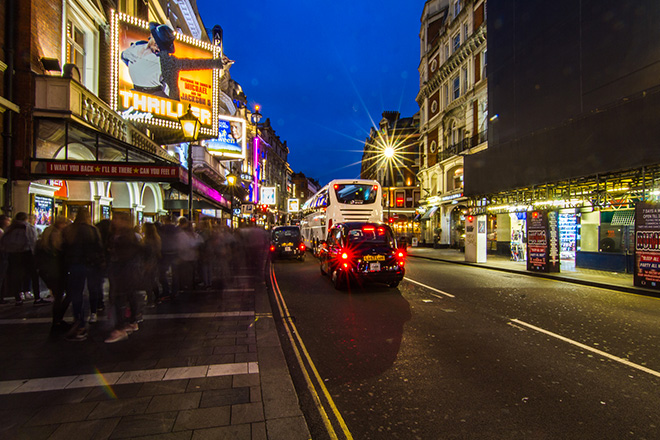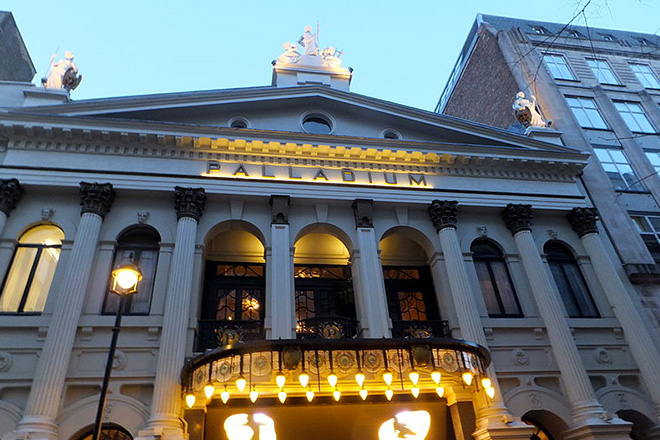The History of the London Palladium: Early Years
Before you head to the London Palladium, it's definitely a good idea to become acquainted with its rich history. As one of London's leading musical, comedy, and drama venues, the theater has seen many iconic events and acts take to the stage, and when you visit you really get a sense of history.
The famous place first opened its doors in 1910 and was mainly intended to function as a place to hold "variety performances." Involving a wide range of acts, from magicians to opera singers, these nights essentially resembled American vaudeville, providing entertainment for almost everyone. However, as with many theaters, it hasn't always had booming business. By 1928, the owners had gone bankrupt, and a new manager took over, a man who would usher in its first golden age.
American Stars in London
George Black had big ideas for the Palladium theater. He sensed that old-fashioned variety acts were finished, and wanted to bring in bigger names, acts that the whole world would be familiar with. While the variety format survived, Black started booking superstars like Duke Ellington and Louis Armstrong - some of the first American musicians to light up the London stage.
At the same time, he nurtured British comedy talent, providing a stage for the "Crazy Gang" to take off. They never made it across the Atlantic, but for a while they were the British equivalent of the Three Stooges, and even royalty idolized them.
The Royal Family Makes it Their Home Away from Home
Speaking of royalty, the Palladium soon became synonymous with patronage from Buckingham
Palace, a status that it still retains today. Beginning in
1930, the theater hosted an annual event called the Royal Variety Performance,
which played out like a star-studded vaudeville show and was one of the first
stage shows to be broadcast by the BBC.
At first, the event took place every May, but soon settled into the annual calendar around November, marking the start of the Christmas entertainment season, and it's still a favorite event for families traveling over to London to shop or enjoy a festive vacation.
At first, the event took place every May, but soon settled into the annual calendar around November, marking the start of the Christmas entertainment season, and it's still a favorite event for families traveling over to London to shop or enjoy a festive vacation.

The London Palladium's Post-War Boom
Returning to the theater
itself, the Palladium continued to grow in prestige after World War II (despite
narrowly escaping destruction when a Nazi bomb failed to explode).
During the post-war era, it hosted world stars like Judy Garland, Danny Kaye, Bing Crosby, Frank Sinatra, Sammy Davis Jr, and Bob Hope. When big American names came to London, they would book themselves into a West End hotel, and prepare for a run of dates at the London Palladium. No West End venue could match its class or capacity.
During the post-war era, it hosted world stars like Judy Garland, Danny Kaye, Bing Crosby, Frank Sinatra, Sammy Davis Jr, and Bob Hope. When big American names came to London, they would book themselves into a West End hotel, and prepare for a run of dates at the London Palladium. No West End venue could match its class or capacity.
Beatlemania Takes off at the London Palladium
But one of the most memorable parts of the theater's history didn't involve any foreign stars. In fact, it involved a group of four Liverpudlians who were just making a name for themselves as a dynamic musical act. In 1963, the Beatles came to London, and were booked onto the 13 October edition of Saturday Night at the London Palladium - one of the biggest television shows of the era.
By this stage, the Beatles were far from established, and they needed to perform well, which they did. But the audience stole the show. With every song, the noise levels rose, as teenage attendees screamed for their idols. By the time "Twist and Shout" began, the Palladium was filled with sound like never before. History records that night as the beginning of "Beatlemania", and it's probably the night that set the group on their way to worldwide stardom.
The Theatre Becomes a Musical Hotspot
While the Beatles dominated
the pop world, the Palladium continued to develop its repertoire. In 1968,
another key milestone was reached when the theater hosted its first musical in
the form of Golden Boy starring Sammy Davis Jr.
At the time, no-one could have known it, but this production would change British theater forever. For the first time, a fully-realized story with proper dramatic parts and high-quality songs played to a packed house in the West End. As Davis Jr. worked his magic, his example began to inspire other composers and artists, and the whole West End started to buzz with ideas for similar shows.
At the time, no-one could have known it, but this production would change British theater forever. For the first time, a fully-realized story with proper dramatic parts and high-quality songs played to a packed house in the West End. As Davis Jr. worked his magic, his example began to inspire other composers and artists, and the whole West End started to buzz with ideas for similar shows.
The 1970s and 80s: A Downturn for the Palladium
Despite setting the trend for musical theater, the Palladium itself had to wait decades to capitalize. Instead, the venue experienced 20 years of stagnation. Major musical artists continued to perform, including Johnny Cash and Cass Elliott (who died soon after finishing a set at the theater), but the glory had faded and the management was struggling. In the 70s, they clung onto their crown jewel, the Royal Variety Performance, but even that was taken away from the London Palladium in the 1980s when venues on Covent Garden began to compete.
The Palladium Returns to its Throne
However, things have improved for this iconic venue. And that renaissance has been mainly due to one very famous and extremely successful man: Andrew Lloyd Webber. His Really Useful Theatre group took over the business in 2000, seeing the potential for staging big box office musicals.
Lloyd Webber is one of the world's greatest musical composers, having penned classics like Jesus Christ: Superstar, Cats, and Starlight Express, so his involvement with the theater was crucial. Since then, lavish productions of The King and I, Chitty Chitty Bang Bang, and Scrooge: the Musical have all been massive successes, while The Sound of Music dominated the schedule for three years between 2006 and 2009.

The Modern Day Palladium
These days, the technology that runs the Palladium is more advanced than ever before. In the past, the stage was huge, and had a famous revolving element which allowed acts to be changed quickly - a big help when staging variety shows.
Since Lloyd Webber came on board, the stage has become much more sophisticated. During a recent production of Sister Act: the Musical, the stage could actually be physically lifted off the ground, allowing regular shows to be staged along with one-off concerts or awards galas. The same technology was used to great effect to make the car "fly" in Chitty Chitty Bang Bang, creating a more immersive, spectacular stage experience.
Some Recent Highlights from the Palladium's History
Every year sees a slate of memorable shows at today's theatre. Since the Really Useful Theatre Company took over, regular musicals have take center stage, but one-off events are also annual highlights. For example, one amazing event was Frank Sinatra's return to the Palladium after more than 40 years in 2006. Then, in 2015, the theater hosted Jerry Lewis' 80th birthday tour. World famous pop and rock acts have come and gone in recent times as well, including Bryan Ferry, Foreigner, the Zombies, Elvis Costello, and Hawkwind, to name just a few.

The Palladium Today
But what about the present day? Is the Palladium still turning out unforgettable productions that are worth seeing when you visit London? You be it is. Youngsters can come and watch magical performances of The Wind in the Willows, while 2017's Dick Whittington reprises a successful run from 2016 and promises the same laughs and family entertainment. And acts like Morrissey, Don McLean, and Yes keep up the tradition of bringing high-quality acts to the venue.
What Are the Views Like at the Palladium?
One of the reasons that the London Palladium has endured and thrived is the way that it was designed. Unusually for theaters around the world, not just in London, the auditorium doesn't have many pillars supporting the various tiers. Architect Frank Matcham wanted to create a theater that offered a completely democratic experience, meaning no attendee would be deprived of a clear view, regardless of how much they paid.
By eliminating columns and making the tiers curve elegantly around the stage, that's exactly what Matcham achieved. Few theaters in the world can match the quality of the London Palladium's views. Whether you're in the Upper Circle, or the corner stalls below, the views are unimpeded. That being said, with its perfect height, the London Palladium Royal Circle view is undeniably just a little bit better.
Getting to Know the Layout of the Theater
The theater itself is divided into four sections: the Upper Circle, the Royal Circle, the Stalls, and a series of boxes. Every seat is upholstered in plush red fabric and the stairwells are gorgeously decorated, giving the venue a palatial feel. And, even though the back of the upper circle is far above the stage, the design is so clever that you don't feel distant.
Even though the views are good from almost every seat, there are some things to think about when selecting your place. For instance, the front stalls are very close to the action, and shorter visitors may struggle to see the whole stage. Stalls to either side also have diagonal views, making them a little less appealing. In the Upper Circle, be aware that the first four rows are slightly impeded by a metal safety rail. As for the Royal Circle, expect more leg room the best views in the house, wherever you sit.
What Else is on Offer
As you'd expect from a modern entertainment venue, this place isn't just a set of seats and a stage. There are on-site catering options for those who don't want to dine out before or after the performance (although the area certainly isn't short of great dining alternatives). There are four bars in the theater itself, where you can pick up a glass of wine, soft drinks, various beers, and even a cocktail or two to liven up the show.
Along with drinks, you can also buy snacks like ice cream and candy, as well as brochures for every show, binoculars (handy for those in boxes or the Upper Circle), and souvenirs like mugs and fridge magnets. Visitors with children can also request booster seats, although supplies are limited, so be quick. There's a cloakroom on-site as well, with a small surcharge per item.
Different Ticket Buying Options at the Palladium
The most expensive tickets at the Palladium tend to be in the Royal Circle, although prices can be high for tickets towards the front rows of the stalls as well. Generally speaking, the Upper Circle will be slightly cheaper, although visitors there will be further away from the action. Then again, there's something magical about watching a show from so high up in the rafters.
The key thing is to shop around and buy wisely, as prices vary massively depending on the date of the show, which show you are attending, and which seats you choose. Price comparison sites like CompareTheatreTickets do a pretty good job at laying out the various options.
How to Book Tickets
There are a number of ways to do so. However, the best way is probably make a purchase via the Palladium website. You'll find all of the upcoming shows listed, as well as schedules well into the future, so it's easy to plan your visit in advance. The booking system also allows you to choose your London Palladium seating options. Instead of a diagram of the available seats, you can highlight the area you'd like to book on a photograph of the auditorium, including the Upper Circle, the Royal Circle, and the stalls below.
Alternatively, you can book via agencies like Ticketmaster or Viagogo, which can often be a good way to buy tickets that are hard to get hold of. Then again, if you're in London, there's always the box office at the door. The London Palladium box office is open between 10:00 and 20:00 (Monday to Saturday), and 10:00 to 18:00 on Sundays, and if you get there early, there may be some bargains to be had.
How to Find the Palladium
All London Palladium events
take place at 8 Argyll Street, in London's Soho
neighborhood. Also known as "Theatreland" due to its high
concentration of venues, Soho
is just north of Westminster, not far from Oxford and Piccadilly
Circus.
The theater is very close to West End hotels and accommodation in areas like Mayfair, and it's also accessible via the London Underground network. Just take the Tube to Oxford Circus, walk south down Regent Street, then left up Little Argyll Street. The Palladium should appear on your right hand side, and you can't miss the bright lights.
The theater is very close to West End hotels and accommodation in areas like Mayfair, and it's also accessible via the London Underground network. Just take the Tube to Oxford Circus, walk south down Regent Street, then left up Little Argyll Street. The Palladium should appear on your right hand side, and you can't miss the bright lights.
Places to Stay Near the Palladium
Looking for a place to lay
your head after a night out at the theater? Luckily, the Soho,
Mayfair,
and West
End neighborhoods of London offer a variety of excellent
options. For example, the Victory House, London Leicester Square is a charming brand new hotel just a ten minute tube
ride (or a fifteen minute walk) from the Palladium. Alternatively, check out 44
Curzone Street for a delightful, old English feel. Regardless of where you
stay, the bright lights and bustle of Soho
will get you in the mood for a night of enthralling performances.
Dining Out Suggestions
Before you take your seats, it's always a good idea to fill up and prepare. Handily, many of the Theatre best restaurants are located near the London Palladium, and many of them offer special "theater menus" with cheap deals for audience members.
Regent Street is a good place to start hunting for food near the London Palladium. There are rooftop tapas bars like Aqua Nueva, vegetarian buffets like Tibits, and Japanese spots like Yami Sushi, all of which are around five minutes away from the theater doors. You'll also find some traditional British pubs near. The Argyll Arms has been around since before the theater was built, while the Clachan also offers an atmospheric setting for meals and a drink or two.
A Classic Venue for Music, Drama, and Comedy
When you pay a visit to this historical place, you'll be stepping into a mythical entertainment venue. The stage below has seen an endless parade of stars, from Louis Armstrong and Duke, to Frank Sinatra, Judy Garland, and of course John, Paul, George, and Ringo. The spirit of concerts and shows lives on with every new production, and you can feel that history when you wait for the performance to commence.
So, if you find yourself in London and need some entertainment, give the Palladium schedules a glance. Sure, there's opera in Covent Garden, soccer at Stamford Bridge or Wembley, and a galaxy of other theaters - but the London Palladium is special.

